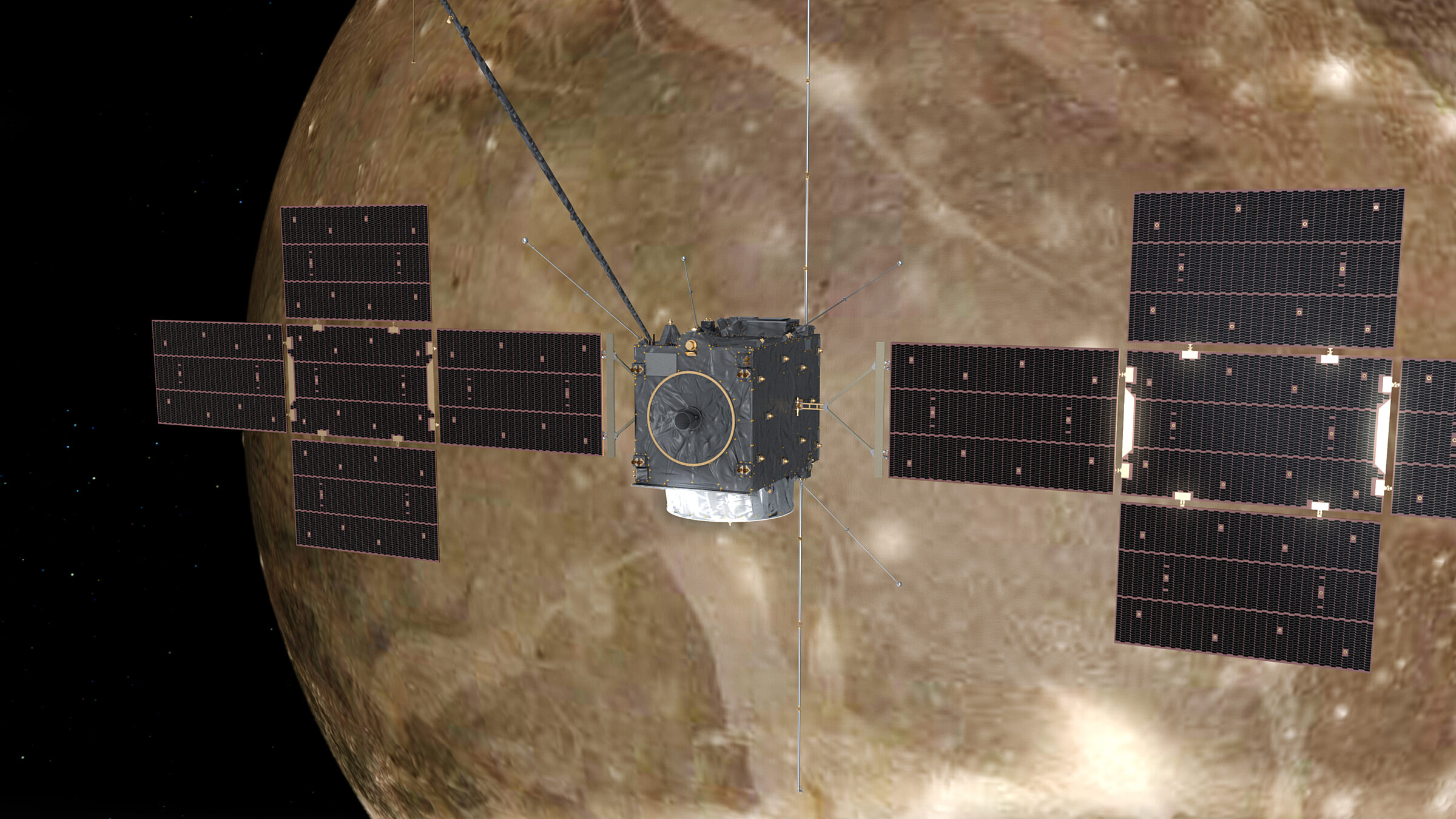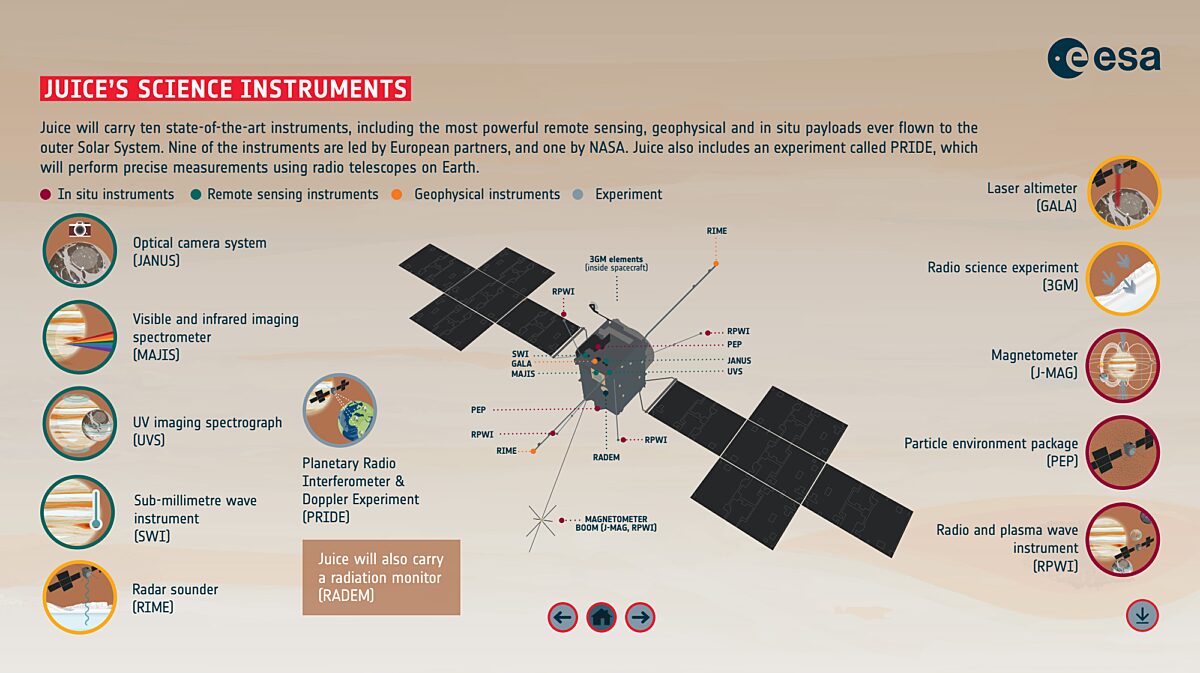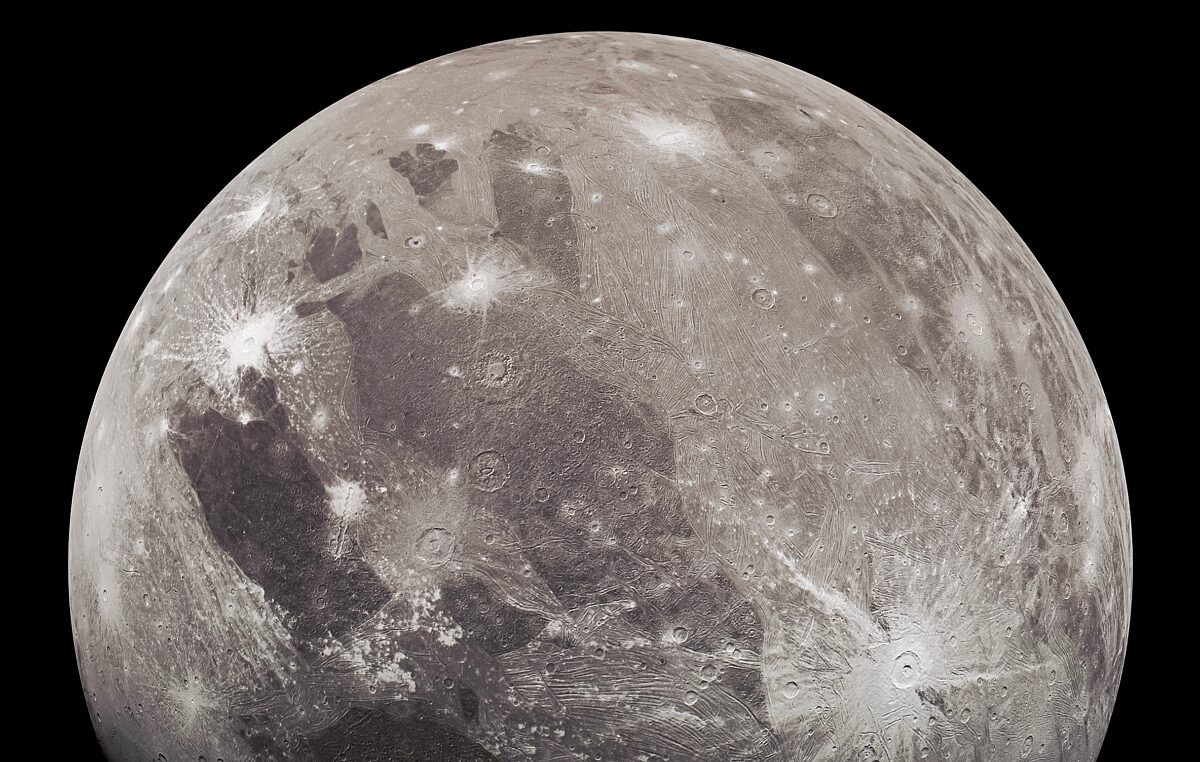Jason Davis • Apr 06, 2023
Juice launch and mission preview: What to expect
The European Space Agency is preparing to launch a mission to uncover the secrets of Jupiter’s icy moons.
Juice will try to determine if conditions are right for life on the moons Europa, Ganymede, and Callisto, all three of which are believed to harbor subsurface oceans. The answers will guide future explorations of these moons and tell us what conditions we might expect to find on moons orbiting gas giants in other star systems.
The spacecraft won’t arrive at Jupiter until 2031. Orbiting the giant planet, Juice will make repeated flybys of Jupiter’s icy inner moons before settling into orbit around Ganymede in late 2034. Larger than Mercury and the dwarf planet Pluto, Ganymede is the only moon in our Solar System that generates its own magnetic field. Juice will explore the habitability of this fascinating world for nine months before intentionally crashing into its surface, ending the mission.

Launch
Juice is scheduled to blast off from ESA’s Spaceport in Kourou, French Guiana on April 14, 2023. Its ride to space is the Ariane 5 rocket, which has launched numerous planetary exploration missions over the years including the James Webb Space Telescope. This will be the final ESA mission to launch on an Ariane 5; the Ariane 6 is scheduled to debut later this year.
The Ariane 5’s upper stage will release Juice 28 minutes after liftoff. The spacecraft’s first milestone comes at about 50 minutes into the mission, when its solar arrays will deploy and start feeding power to the vehicle. More deployments of the spacecraft’s antennas, probes, and magnetometer booms will occur within the mission’s first 17 days.
Getting to Jupiter
Juice will use the gravity of multiple worlds to tweak its trajectory and put it on course for Jupiter.
After launch, Juice will orbit the Sun roughly on the same track as Earth. In August 2024, it will perform the first-ever lunar-Earth gravity assist, first flying past the Moon and then Earth one-and-a-half days later. (If Juice’s launch is delayed past April 18, 2023, it will only fly past the Earth.)
From there, Juice will perform three more flybys:
Venus flyby in August 2025
Earth flyby in September 2026
Earth flyby in January 2029
After that, the spacecraft will arrive at Jupiter in July 2031.
Juice's journey to Jupiter ESA's Juice, the Jupiter Icy Moons explorer, will use the gravity of multiple worlds to tweak its trajectory and put it on course for Jupiter, where it will arrive in 2031.
Science
Juice is equipped with 10 science instruments, a radiation monitor, and a radio experiment that together constitute “the most powerful remote sensing, geophysical, and in situ payloads ever flown to the outer Solar System,” according to ESA.
The remote sensing instruments will image the moons in a variety of wavelengths, determining the makeup of ices and minerals on their surfaces and scanning the regions around them for potential water plumes.
The geophysical instruments include an altimeter as well as a radar that will peer beneath the moons’ surfaces to a depth of 9 kilometers (5.6 miles). Juice’s communications system doubles as an experiment that will allow radio telescopes on Earth to measure how the gravity fields of Jupiter and its icy moons tug on the spacecraft.
The in situ instruments will study particles and plasma fields throughout the Jupiter system. Among other things, this will help scientists understand how volcanic activity on Io shapes the region.

Packed with science instruments, Juice is a beefy spacecraft. Without fuel, it has a mass of 2.4 metric tons (5,300 pounds). The spacecraft’s two cross-shaped solar arrays have a combined area of 85 square meters (915 square feet). The cost of the mission is 1.6 billion euros, equivalent to $1.7 billion.
At Jupiter
Upon arriving at Jupiter, Juice will perform 35 flybys of Europa, Ganymede, and Callisto between July 2031 and November 2034.
The majority of those — 21, to be precise — will be at Callisto, the most heavily cratered world in our Solar System. Callisto may have a deep, subsurface ocean in contact with underlying rock, which could create an environment conducive to life. By studying Callisto’s gravity field and zapping it with radar, Juice should get a better idea of what’s happening beneath the surface.
Juice will fly past Europa twice, focusing on cracks in the moon’s surface where material is possibly being exchanged with the subsurface ocean. The spacecraft will examine these regions for elements essential to life and for substances that could be tied to past or present life. NASA’s Europa Clipper mission is slated to arrive at Jupiter a year earlier in 2030; ESA says the two mission teams meet once a year to compare notes and maximize the science return from both space probes.
Juice’s primary target is Ganymede. The spacecraft will fly past the moon 12 times before entering orbit in December 2034, marking the first time a spacecraft has orbited a moon besides our own.

Ganymede is the only moon known to have a magnetic field, likely created from a molten iron core. The field creates auroras that have been detected by the Hubble Space Telescope. Juice will study this field, which lies within Jupiter’s larger magnetic field, to help scientists understand the complex interactions between both worlds.
Ganymede has a subsurface ocean, but we don’t know where it begins or how deep it is. Juice will attempt to shore up these basic facts, while also studying the moon’s composition and the intriguing bands splashed across the surface. The spacecraft will look for possible biosignatures that might bolster the chances of life developing on icy moons.
In September 2035, ESA will intentionally crash Juice into Ganymede, ending the mission. The spacecraft was not required to be sterilized under planetary protection rules because there is currently no evidence that Ganymede’s subsurface ocean is in contact with the surface. Should Juice find evidence to the contrary during its flybys, ESA says it will reconsider its end-of-mission plans.
The Time is Now.
As a Planetary Defender, you’re part of our mission to decrease the risk of Earth being hit by an asteroid or comet.
Donate Today

 Explore Worlds
Explore Worlds Find Life
Find Life Defend Earth
Defend Earth

